There isn’t any state east of the Mississippi river with a larger population than North Carolina. And that doesn’t only apply to humans, but birds as well.
The Old North state, as it’s commonly called, is the 28th largest state. It comprises nearly 54,000 square miles, and 470 bird species use it as their home or breeding location.
The variety of lands in the state account for the various creatures living in it. As a matter of fact, it’s home to the highest mountains in the Eastern US.
Out of the 470 species, there are 25 types of birds in North Carolina to watch out for. Here’s a list classified by color to make matters easier for you!
Red Birds in North Carolina
Northern Cardinal

- Scientific Name: Cardinalis cardinalis
- Length: 8.3–9.1 inches
- Weight: 1.5–1.7 ounces
- Wingspan: 9.8–12.2 inches
Northern cardinals are the official state bird of North Carolina, which gives you an idea of how common the bird is there.
This familiar bird is the most common backyard bird in the US. They have a distinctive appearance with their thick bills and round red bodies with a few white spots on their feathers.
You’ll mostly find them on low shrubs or tree branches. However, they also forage close to the ground frequently in search of worms.
Their call sounds like cheer cheer cheer.
Red-Bellied Woodpecker

- Scientific Name: Melanerpes carolinus
- Length: 9.4 inches
- Weight: 2–3.2 ounces
- Wingspan: 13–16.5 inches
Red-bellied woodpeckers only have red on top of their heads. Otherwise, they gained their name because their bellies blush a deep red.
Their wings are a seamless blend of white and black feathers, and they’re easily identified from other woodpeckers because they don’t have crests.
This woodpecker species lives in North Carolina all year round, so your chances of seeing them are pretty high.
The adult woodpecker mostly sticks to its territory unless it’s migrating. And, this common feeder bird will visit sites that provide sunflower seeds or peanuts.
House Finch
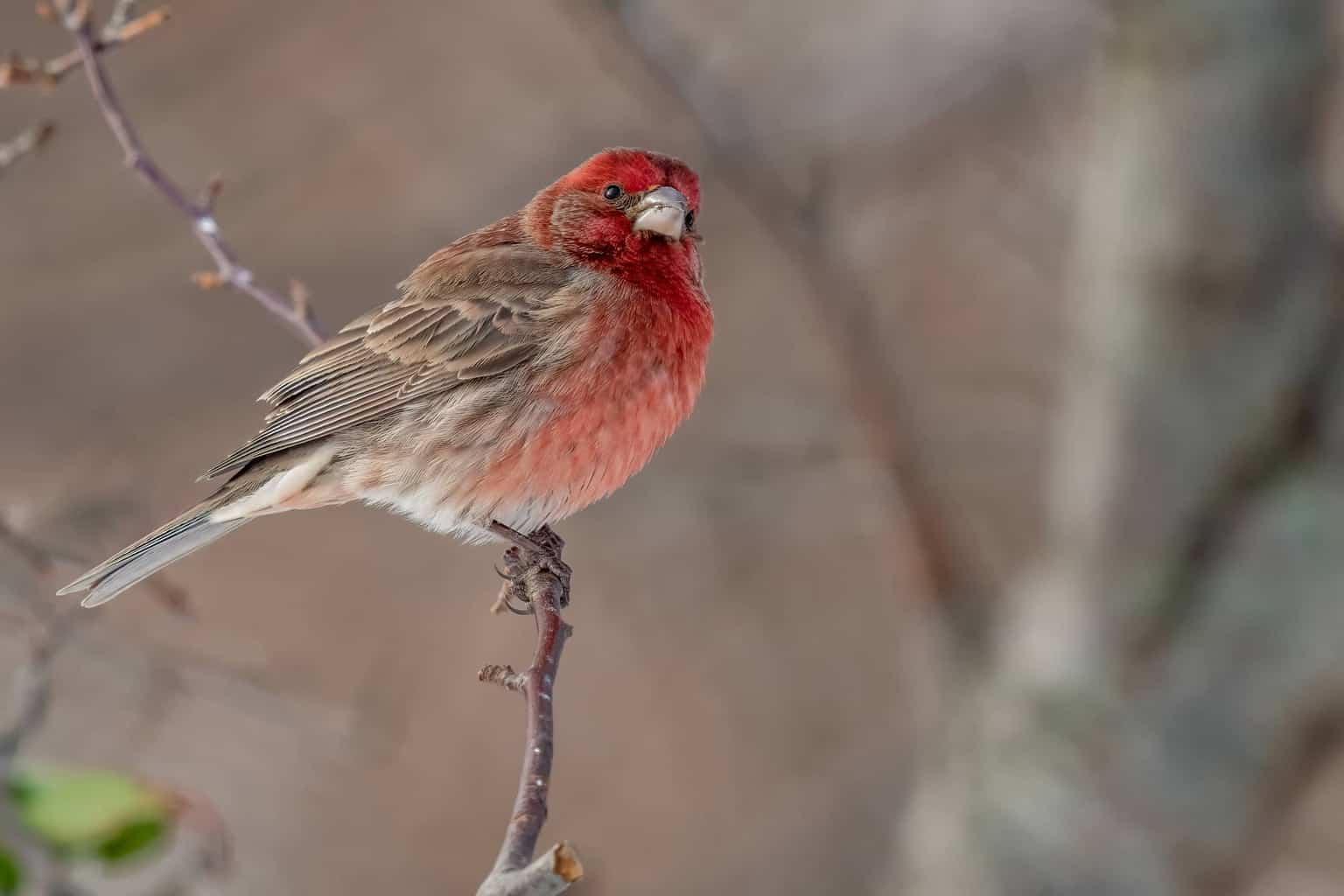
- Scientific Name: Haemorhous mexicanus
- Length: 5–6 inches
- Weight: 0.6–0.9 ounces
- Wingspan: 8–10 inches
House finches first appeared in North Carolina in the late 1960s. Merely a decade later, their population significantly surged across the whole state.
Now, you can find house finches in any part of the state you’re visiting.
It’s easy to identify these birds because they have red upper bodies. Their wings are a mix of brown and beige shades.
Bear in mind, though, that female house finches don’t have a hint of red in their bodies. So you’ll only be looking for the males.
Red-Winged Blackbird

- Scientific Name: Agelaius phoeniceus
- Length: 9–10 inches
- Weight: 2.5–3 ounces
- Wingspan: 12–16 inches
Red-winged blackbirds are unlike any other red bird you may see.
They have black bodies adorned by red shoulder caps that stand out in striking contrast. You can spot that red patch a mile away.
These birds are year-round residents of North Carolina. They prefer staying near marshes in the summer, and they inhabit meadows and pastures when the weather gets cold.
Blackbirds love to make their presence known. So when they feel someone is watching them, they’ll perch high and start singing.
Blue Birds in North Carolina
Blue Jay
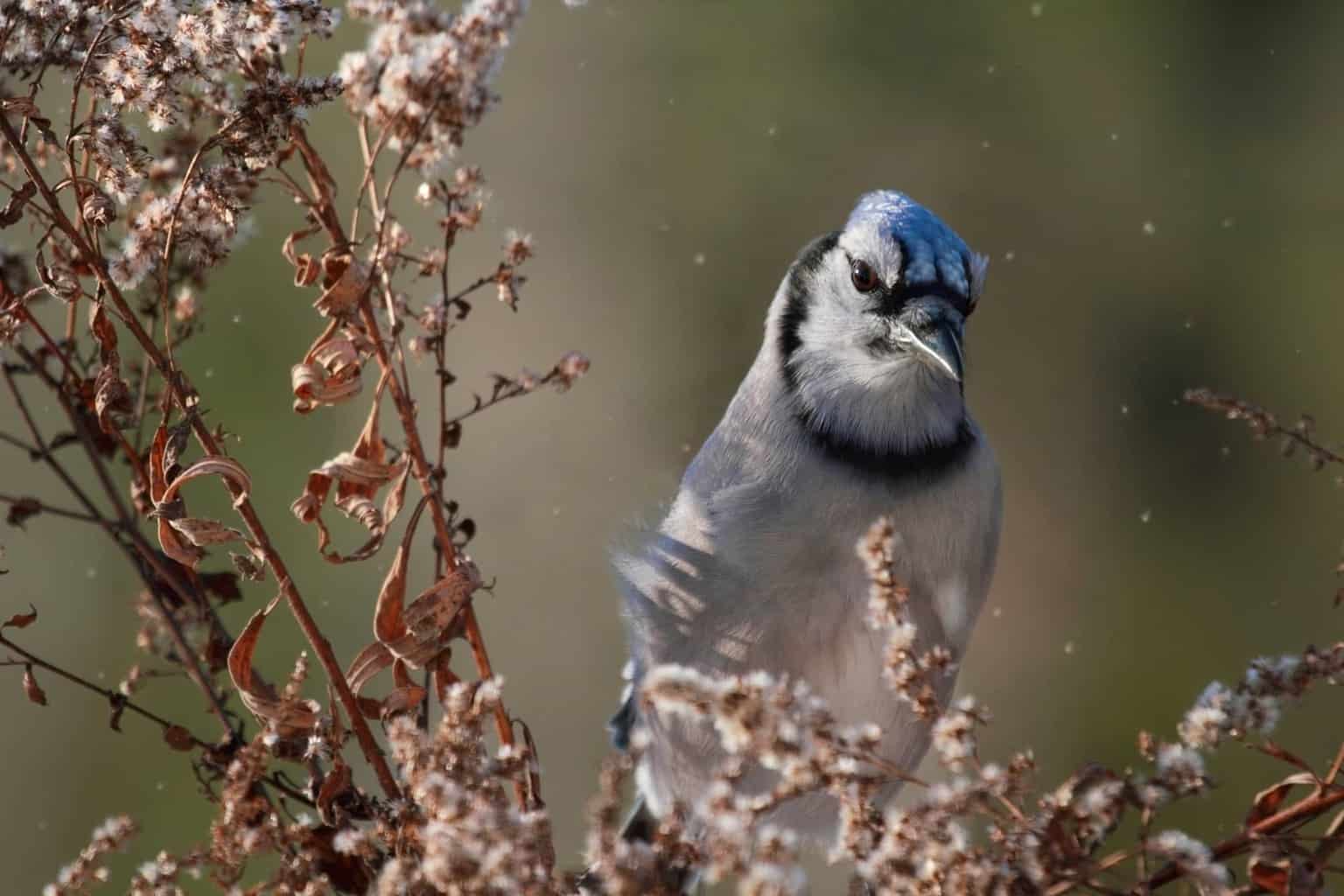
- Scientific Name: Cyanocitta cristata
- Length: 9–12 inches
- Weight: 2.5–3.5 ounces
- Wingspan: 13–17 inches
If you’ve been living in the US for a long time, you’ve probably encountered the Blue Jay a few times. You’ll remember their appearance because one of the most visually appealing birds in the world.
Except for some individuals with lavender plumage, Blue Jays have blue bodies–obviously! You can easily identify them by looking for the unique blue color on their wings, ample tail, and back.
If you want to see this beautiful bird species, fill your feeder with peanuts and sunflower seeds. You may even get lucky and hear the hawk-like sound that they use to interact with their fellows.
Mountain Bluebird

- Scientific Name: Sialia currucoides
- Length: 6.5–8 inches
- Weight: 1–1.5 ounces
- Wingspan: 11–14 inches
Mountain bluebirds look like balls of blue ice. The sky blue on their bodies isn’t too vibrant, but it’s bright like it just came out of a freezer—almost like the sky’s color on a cold November morning.
Only the males have this beautiful plumage. The females have gray plumage with pale blue tinges on their tails and around their wings.
These birds are known for pouncing on their insect prey from above. So, they’re often seen hovering and perching on high branches of trees.
You can find them near high elevations, and they breed in prairies and alpine tundra.
Lazuli Bunting
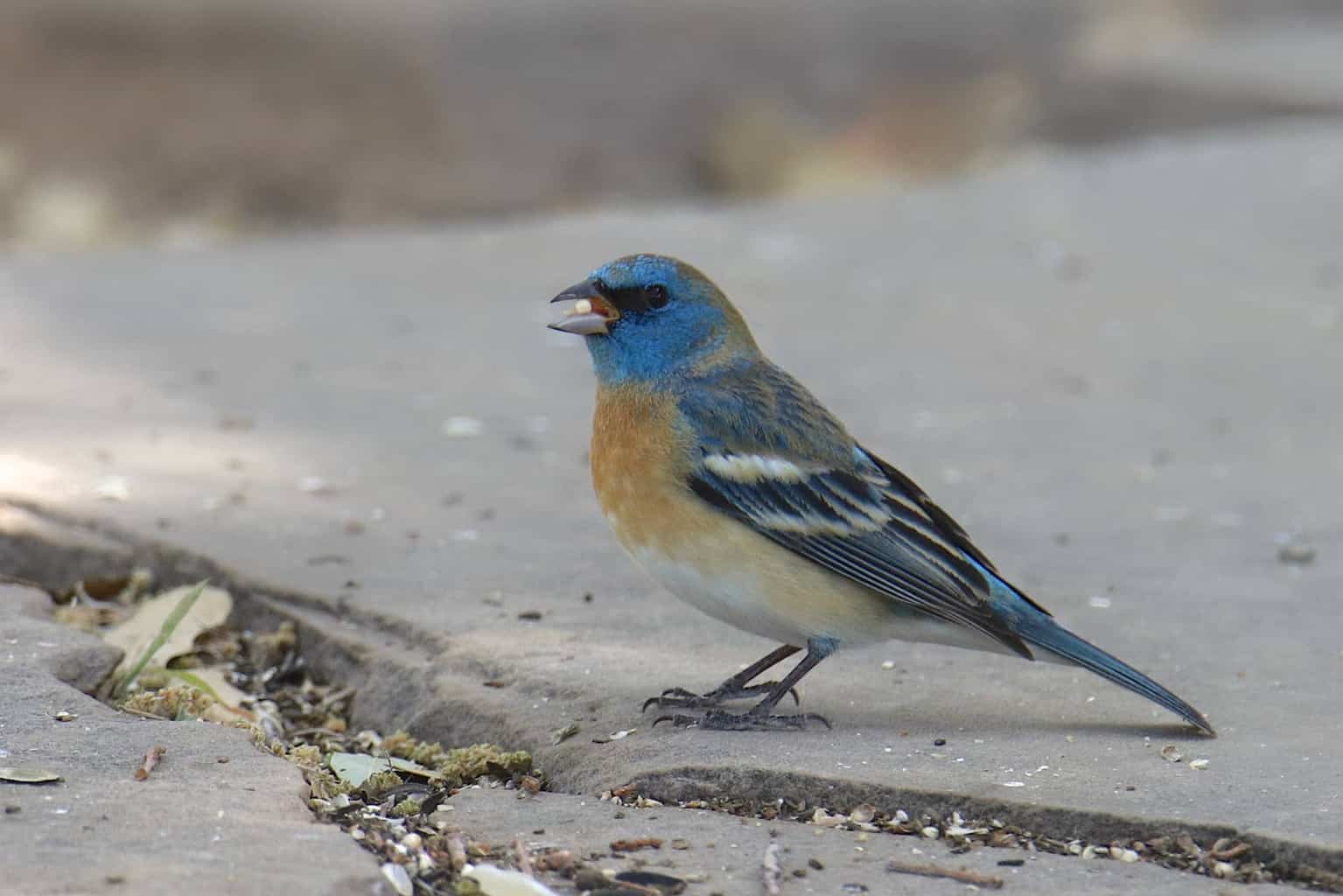
- Scientific Name: Passerina amoena
- Length: 5–6 inches
- Weight: 0.5–0.7 ounces
- Wingspan: 8.7–9 inches
Lazuli buntings look exactly like indigo buntings from the neck up. However, the rest of their bodies look more like grosbeaks.
They have a bright blue head and pale peachy front. Their underbelly is white, and their wings are a blend of these colors, in addition to gray.
You can find lazuli buntings in various places, including streams, agricultural fields, and wooded valleys. They’re also frequent visitors to residential gardens.
Eastern Bluebird

- Scientific Name: Sialia sialis
- Length: 7–8 inches
- Weight: 1–2 ounces
- Wingspan: 11.5–13 inches
Under poor lighting conditions, you may not distinguish this beloved bird from a blue grosbeak or an indigo bunting.
However, the fact that eastern bluebirds have only three colors on their bodies may help you. They come in blue, peachy, and white colors.
These birds spend most of their time around parks, open fields, and golf courses.
Common Grackle

- Scientific Name: Quiscalus quiscula
- Length:L 11–13 inches
- Weight: 2.6–5 ounces
- Wingspan: 14–18 inches
Common grackles hold their name to high standards; they’re one of the most common birds in North Carolina all year long and a permanent resident of the state. You can easily catch them if you look closely.
Common grackles have black bodies with distinctive blue heads. They also have iridescent feathers, which add to their allure.
Grackles eat nearly everything, so it’d be enough to fill your bird feeder with sunflower seeds or whatever you have available.
Green Birds in North Carolina
Anna’s Hummingbird

- Scientific Name: Calypte anna
- Length: 3.9–4.3 inches
- Weight: 0.1–0.2 ounces
- Wingspan: 4.7 inches
You won’t have difficulty distinguishing Anna’s hummingbirds from other hummingbirds because of their unique sparkly red heads and iridescent green wings. As you’ve guessed by now, they’re exceedingly beautiful birds.
If you want to see Anna’s hummingbird’s magical appearance, you should look around gardens and bright-colored blossoms. They’re also pretty common in backyards during spring.
To study them closely in your backyard, you can attract them with some raisins and seeds in your bird feeder.
Green-Breasted Mango
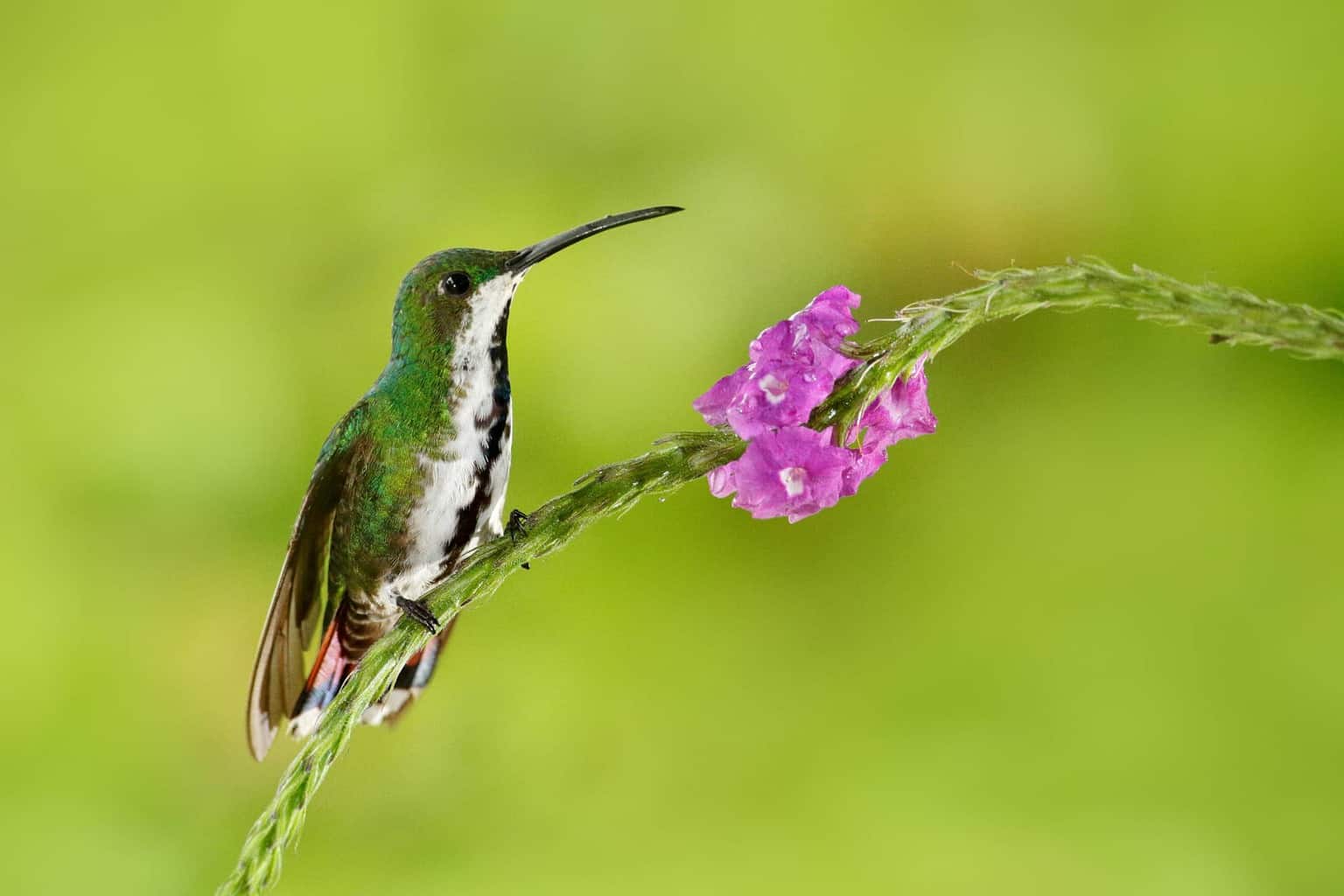
- Scientific Name: Anthracothorax prevostii
- Length: 2–3 inches
- Weight: 6–6.5 ounces
- Wingspan: 4.75–5 inches
Green-breasted mangos don’t look like any other green birds. Although they’re hummingbirds like Annas and Calliopes, they have distinctive bodies with colorful plumage.
Their bills are long and arched, and their tails are bright red or orange under the sunlight. They have a flower-like shape that spreads out behind the birds as they fly.
Mangos’ feathers are iridescent, so they look shiny under strong lighting.
In North Carolina, you can see green mangos in rural areas, but they’re not too common. Sightings in the states have been declining in the past ten years.
Buff-Bellied Hummingbird
- Scientific Name: Amazilia yucatanensis
- Length: 4–4.3 inches
- Weight: 0.1–0.3 ounces
- Wingspan: 5–5.75 inches
Buff-bellied hummingbirds are among the rare or accidental sightings in North Carolina. They make occasional appearances in the state, but they don’t stay for long.
They look a bit like green-breasted mangos, but they don’t have the same color combination.
Their bills are long and arched, and their tails have the same flowery shape.
Their bodies are green, their wings are dark grey, and their bellies are white. On the front, the green only goes around their necks.
Calliope Hummingbird
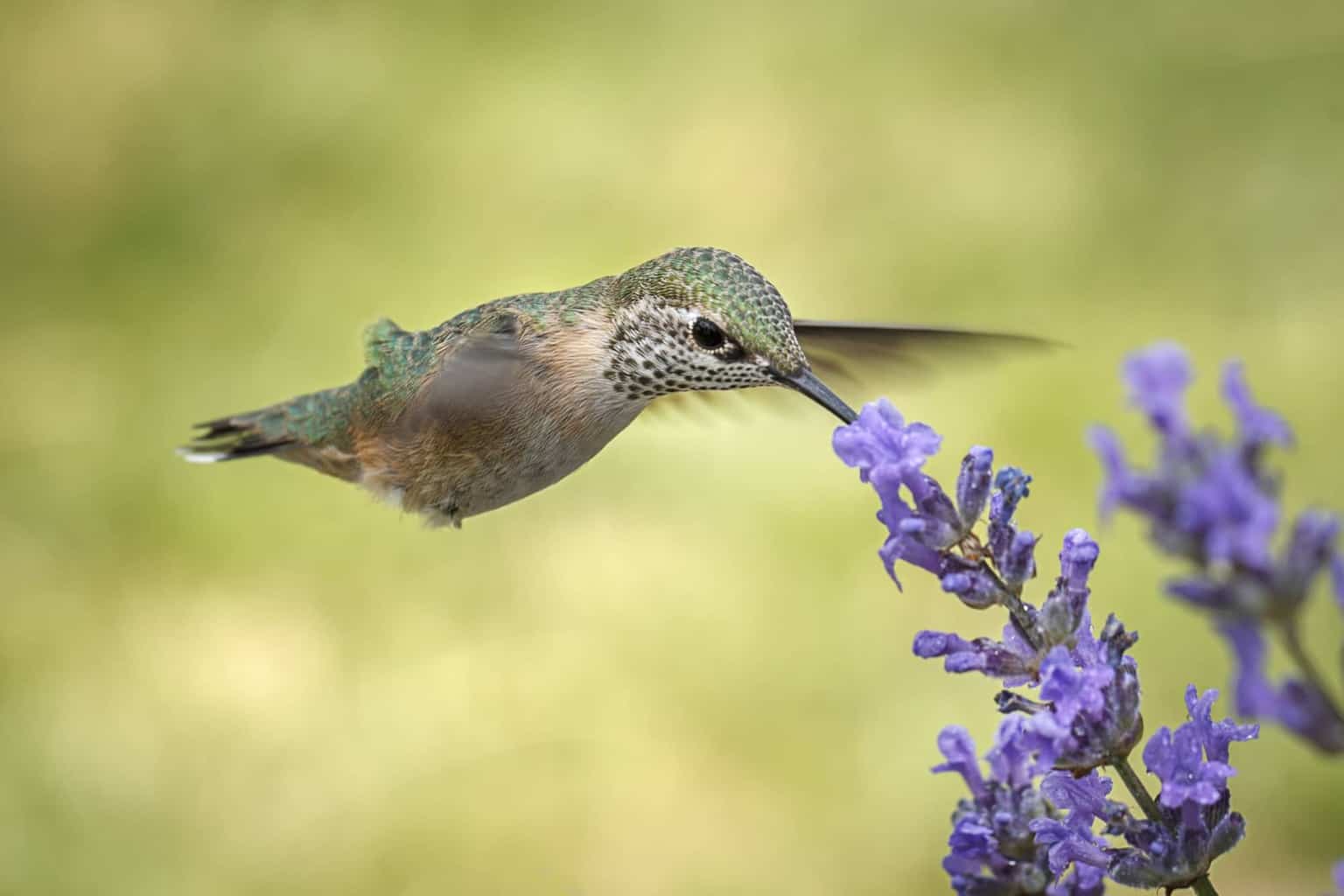
- Scientific Name: Selasphorus calliope
- Length: 2.8–3.9 inches
- Weight: 0.071–0.1 ounces
- Wingspan: 4.3 inches
Calliope’s hummingbirds are easily distinguishable from other hummingbirds, mainly because of their unique colors. Males have bright glittery Fuschia necks, while females have shining green wings.
Calliopes are categorized as the smallest birds in North America. Thus, it may be harder to catch them. But they’re pretty common during the winter in North Carolina.
Calliope hummingbirds love a generous supply of nectar, so you’ll mostly encounter them near willows and alders. They love perching there.
Ruby-Throated Hummingbird

- Scientific Name: Archilochus colubris
- Length: 3–4 in
- Weight: 0.1–0.5 oz
- Wingspan: 4–4.5 in
The adult Ruby-throated hummingbird is the most common hummingbird in North Carolina. It lives and breeds in the Eastern state, and its numbers are on the rise.
The bird has a long, pointed bill. It also has green wings, underbelly, tail, and crown. The feathers are iridescent, too, so they look shiny under the sunlight.
The bird has a ruby-colored neck that appears bright against the green feathers, making the bird stand out among the crowd.
Although small, these birds fly with great power. Their wings move rapidly, and they’re among the few birds that are capable of flying backward.
Orange Birds in North Carolina
Carolina Wren

- Scientific Name: Thryothorus ludovicianus
- Length: 5–5.5 inches
- Weight: 0.6–0.8 ounces
- Wingspan: 10–11 inches
Carolina wrens have pale orange underbellies and beige-brown wings. Their entire body coloration leans towards orange, and they’re the most common wrens in North Carolina.
Carolina wrens are also among the most common backyard birds in the Eastern United States. They’re around the same size as an American goldfinch or a house finch, and they can fit in your backyard feeder just fine.
These birds spend most of their time around brushy yards and shrubby thickets. The males are best known for their call that sounds too loud for their small size.
American Robin
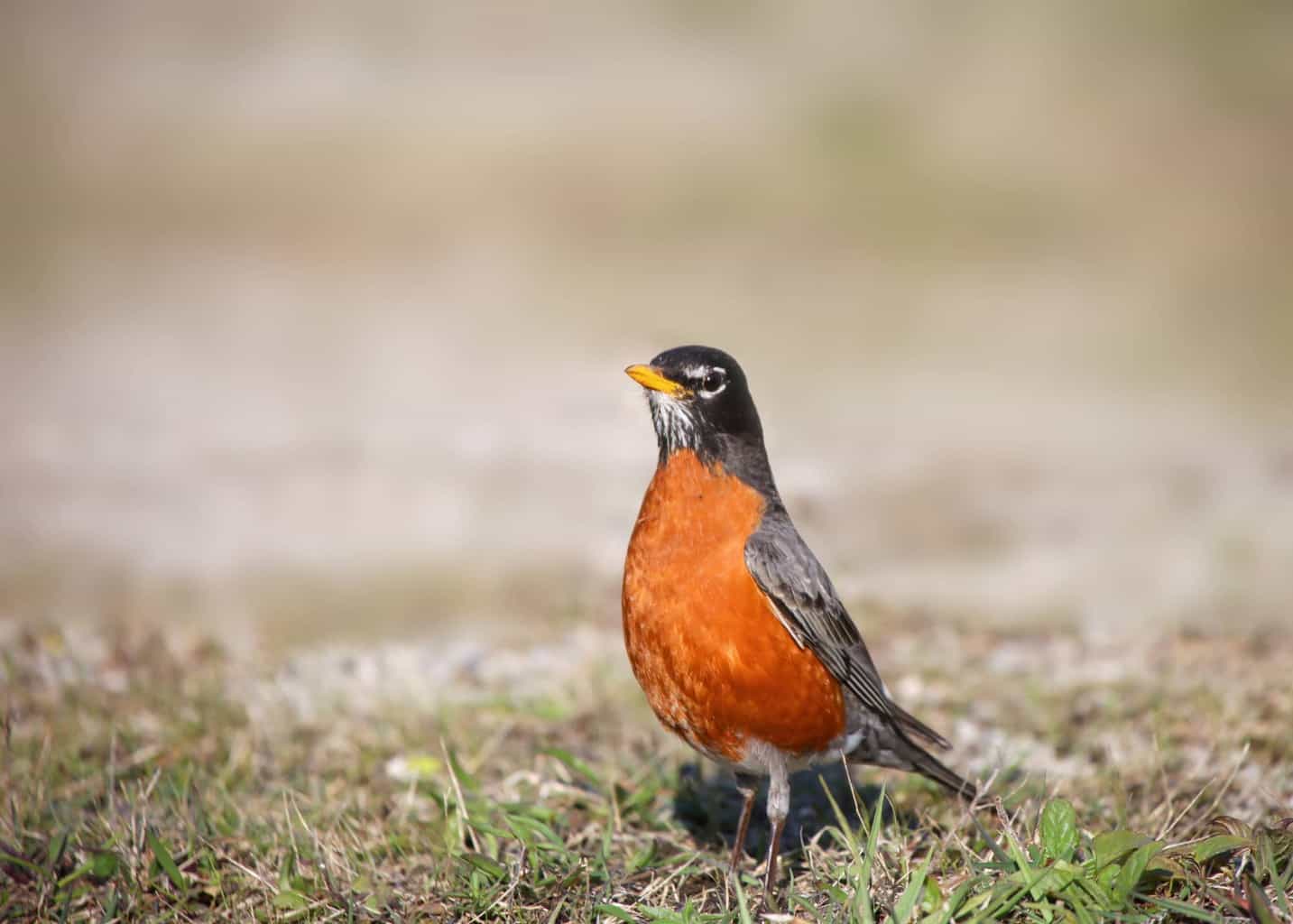
- Scientific Name: Turdus migratorius
- Length: 9.1–11.0 inches
- Weight: 2.5–3 ounces
- Wingspan: 12–16 inches
American Robins are one of the most abundant birds in North America and as common as Mcdonald’s franchises in the US. You’ve likely seen them a couple of times.
They’re famous for their light gray wings and orange chests. Also, you can identify them by their sound. They make a cheerful, loud tone that bird watchers can hear from far away.
American Robins are urban birds; they can comfortably live in cities and populated areas. But you may also encounter them in the wild.
To attract Robins to your backyard, put some fruit seeds, peanuts, and black oil sunflower seeds in your feeder.
Eastern Towhee

- Scientific Name: Pipilo erythrophthalmus
- Length: 7–9.1 inches
- Weight: 1.1–2 ounces
- Wingspan: 8–11.8 inches
The Eastern towhee has an incredibly attractive coloration. This small-sized bird has black wings, a black head cap, and a long black tail with orange sides, and a white underbelly.
These birds look like sparrows, and they’re about the same size as well, but they’re a bit less bulky. They’re larger than hummingbirds but smaller than red-winged blackbirds.
The Eastern towhee females are more brown than orange, and their coloration is paler overall.
You can find these birds around woodland hedges, brushy areas, and residential gardens. During the hot months, this migratory bird species moves to Canada.
Towhees feed on many kinds of insects, seeds, and fruits. They may pay a visit to your hopper feeder, but they generally prefer platform feeders because they’re large enough to accommodate their size.
Baltimore Oriole

- Scientific Name: Icterus galbula
- Length: 6.6–7.5 inches
- Weight: 1–1.4 ounces
- Wingspan: 9–11.8 inches
A bird with an entire Baseball team named after it must be one of a kind, right? Well, the Baltimore Orioles are definitely not here to disappoint!
You can easily distinguish the Baltimore orioles’ gender because the males have lively orange bodies with black backs and heads. Meanwhile, the females are more on the pale side with duller colors; black is just not in their dictionary.
If you want to encounter these lovely orange birds, you should set your scope near open woodlands and forests. They spend most of their time there.
Yellow Birds in North Carolina
American Goldfinch
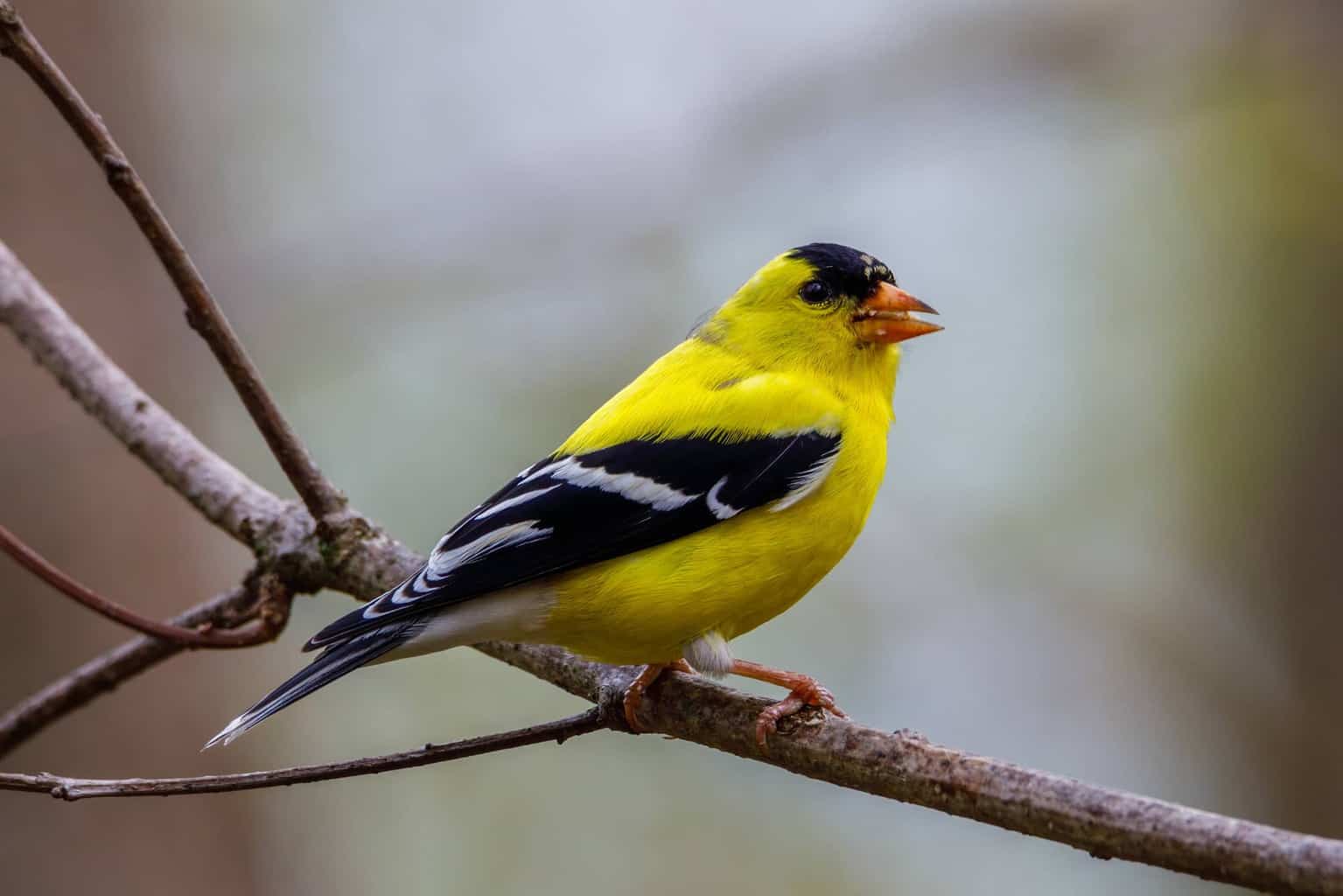
- Scientific Name: Spinus tristis
- Length: 4.3–5.5 inches
- Weight: 0.39–0.71 ounces
- Wingspan: 7.5–8.7 inches
American goldfinches are most famous for their appearances; these attractive birds have a vibrant yellow body and black forehead. Although you may notice that the males are more on the bright side nevertheless, you’ll find the yellow body color in both genders.
These colorful birds have unique flying movements; they bounce up and down with spread wings, making for an exquisite appearance. You may also be lucky to see them showing off some flapping moves.
To attract American goldfinches, lay some seeds and thistles out for them. Look in weedy areas and clearings if you want to go the extra mile and find them yourself.
Tyrant Flycatcher

- Scientific Name: Spiza americana
- Length: 2.6–2.8 inches
- Weight: 1–1.5 ounces
- Wingspan: 5–5.9 inches
Tyrant flycatchers are among the passerine bird family. The passerine family is the largest group of bird species on Earth, including more than 400 species.
The tyrant flycatchers are among the smallest species in the family. They’re common across North and South America, and they look strikingly similar to Old World flycatchers. However, they have more substantial bills, and their bodies are overall bulkier.
These birds aren’t vocal like other songbirds. You’ll seldom hear their call, and it’ll sound plain if you do.
Flycatchers feed on insects, as their name implies. They’re not present in North Carolina year-round, but they have been recorded more often than more rare birds.
Dickcissel
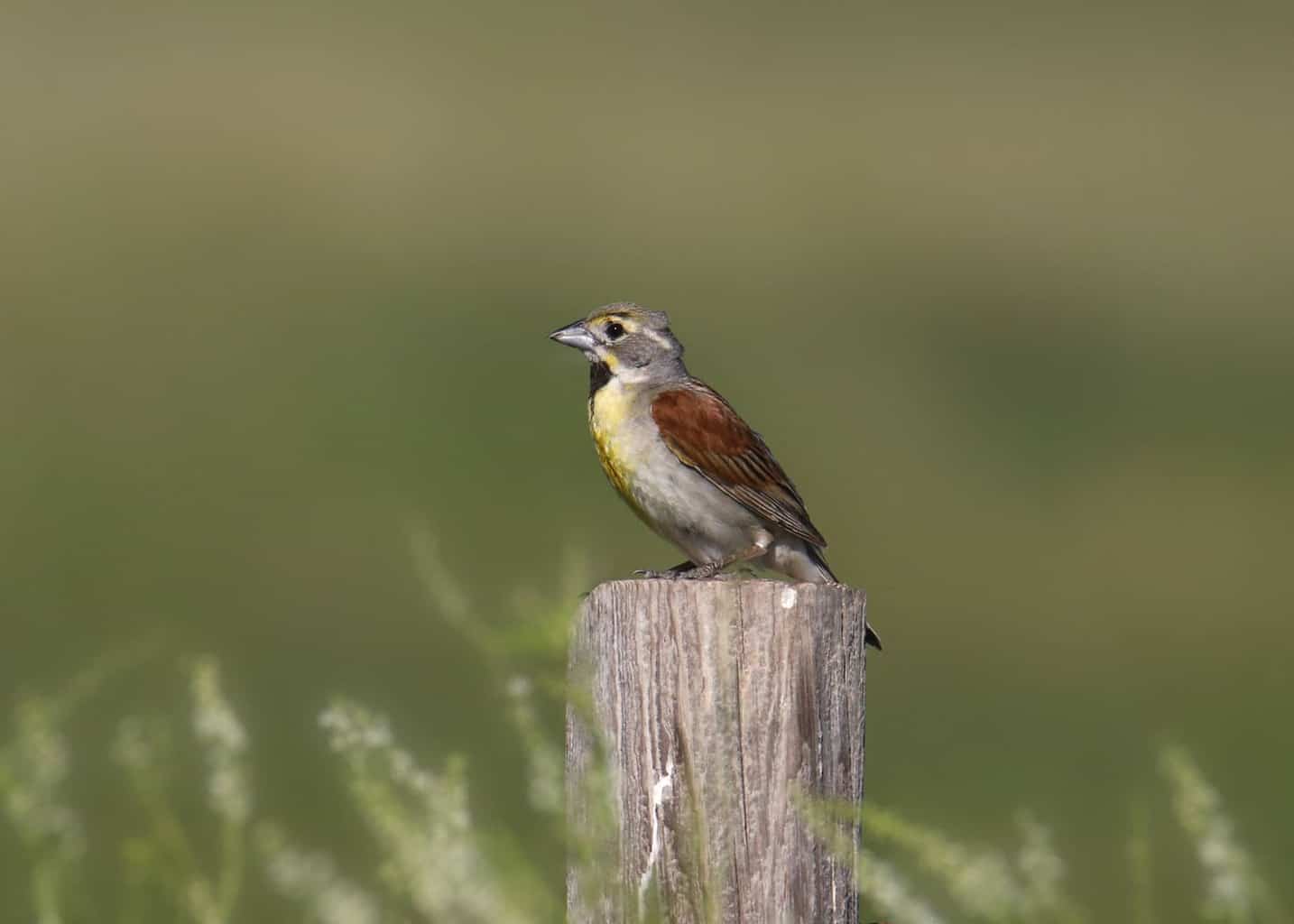
- Scientific Name: Spiza americana
- Length: 5.5–6.3 inches
- Weight: 0.9–1.4 ounces
- Wingspan: 9.8–10.2 inches
The Dickcissels, named after the sound they make, are erratic breeders that are worth looking for.
Unlike many other birds on the list, Dickcissels may be a little hard to identify because their appearance is pretty common.
Don’t lose hope, though, because males can be identified by their chest area; it looks somewhat like two Vs. The upper one is black, and the lower one is yellow. They also have white bellies.
To catch them, you should go to grassland areas, hayfields, pastures, and prairies. You’ll most probably find them all year round.
Other Birds To Watch For in North Carolina
Mourning Dove

- Scientific Name: Zenaida macroura
- Length: 11–12 inches
- Weight: 4–6 ounces
- Wingspan: 17–17.7 inches
Mourning doves are familiar backyard visitors in most of the states, North Carolina included.
They have a beautiful tan and white plumage and black spots scattered across their wings. Male and female birds have similar body shapes. You’ll mostly see them perching on telephone lines or foraging near the ground.
If you have a platform feeder, you can expect to see this abundant bird species near it. They only feed on those because they prefer to stay in open spaces. They likely won’t appear at smaller feeders.
Carolina Chickadee

- Scientific Name: Poecile carolinensis
- Length: 3.9–4.7 inches
- Weight: 0.3–0.5 ounces
- Wingspan: 6–7.9 inches
Carolina chickadees are the most common chickadees in North Carolina. The family is most common across all states, but Carolinas, in particular, are abundant in the South-Eastern part of the country.
If you have a backyard bird feeder, you’ll undoubtedly see a couple of Carolinas all year round. They’re about the same size as an American goldfinch and have round bodies and long tails.
Other than near backyard feeders, you can find Carolina chickadees near deciduous forests at low elevations, as well as near residential areas and water bodies.
Purple Gallinule

- Scientific Name: Porphyrio martinicus
- Length: 10–15 inches
- Weight: 5–10.8 ounces
- Wingspan: 20–24 inches
Purple gallinules are rare in North Carolina, but there have been some recorded sightings. You’d be lucky to run across one of them because these birds are magnificent.
They have green wings, purple bluish fronts, and bright red beaks with a yellow tip. These birds walk like chickens, and they have similar long talons. However, they look more like ducks.
They’re members of the rail family, and they’re commonly known as swamp hens.
You can find purple gallinules in marshes. You may be surprised to see them floating or walking on lily pads, but their long talons help them cross the water easily.
European Starling
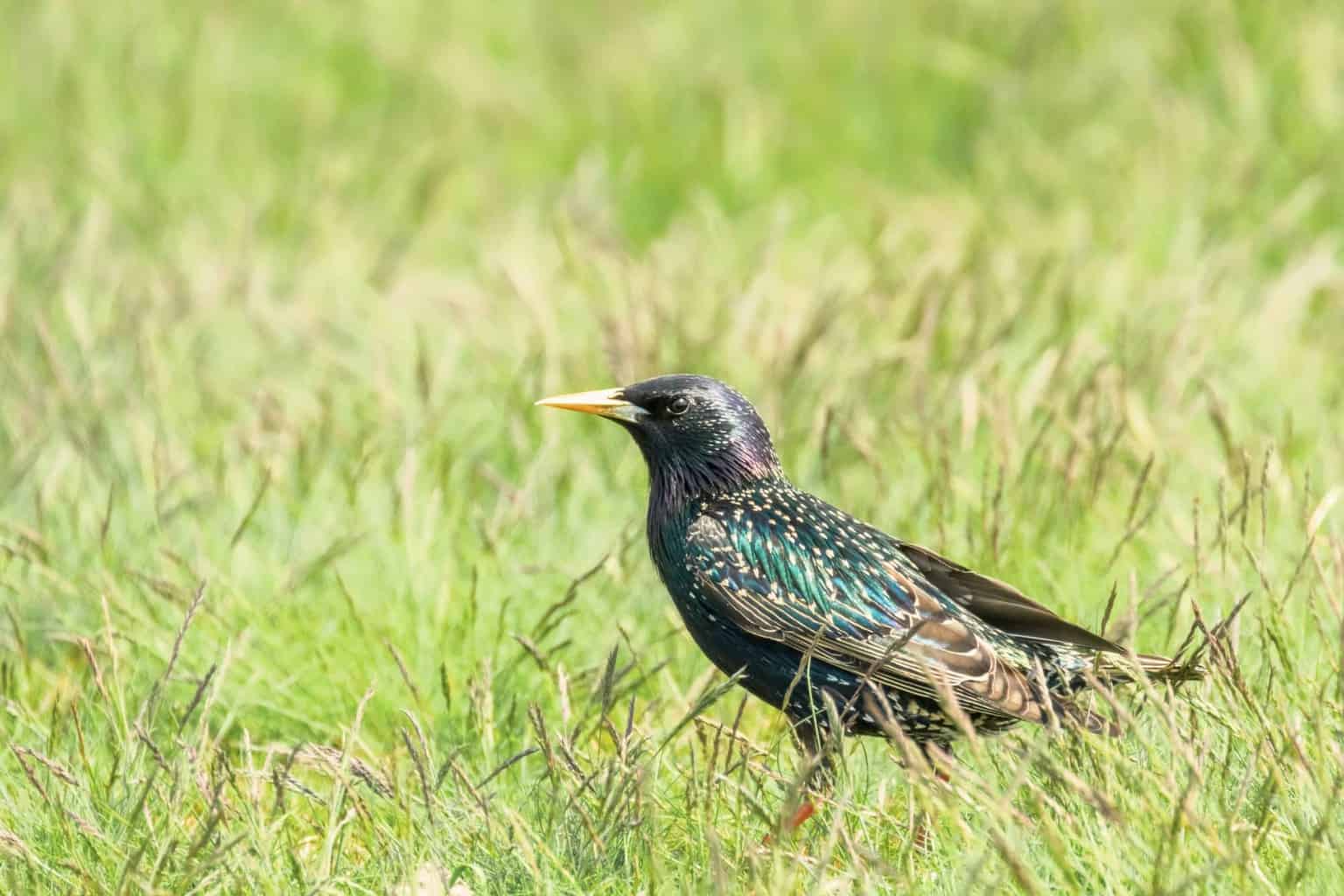
- Scientific Name: Sturnus vulgaris
- Length: 8–9 inches
- Weight: 2–3.5 ounces
- Wingspan: 12–16 inches
European starlings are one of the most visually appealing bird species you can encounter in your life. Their beautiful appearance can be attributed to their shimmering feathers that hold a unique color mix of dark blue and purple.
If you’re lucky enough, you’ll catch them in the light because you’ll be able to see their magical appearance vividly then.
You can find European starlings abundantly in fields, city streets, and parks. Ironically, they’re more commonly spotted on the ground than in the sky because they look for insects to feed on in the soil.
Wrap Up
As you can see, there are birds of all colors in North Carolina. There’s a huge variety, so you’ll undoubtedly get lucky and run across at least 5–10 of these species of birds.
You can walk around marshes, wooded lands, and open fields to get lucky. There are also a lot of species that live and breed near mountainous areas with high elevations.
Get your binoculars ready, your hat on your head, and pack lots of water because you’ll need it for your bird-watching trip in the Old North state!











